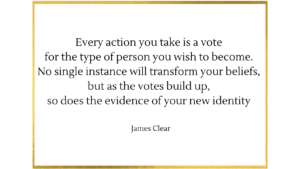I first started using affirmations over 20 years ago, after reading Ask and It is Given and The Secret.
Back then, affirmations were largely dismissed as wishful thinking.
Now, what once was thought of as woo has since been confirmed by science.
What are affirmations?
An affirmation is an assertion, statement, or declaration about something.
It can be positive or negative.
The fact is you are constantly affirming beliefs to yourself. This becomes a problem when your affirmations are mostly negative.
The good news if that by being aware of what you are affirming, you can change what you are saying to yourself in a much more conscious manner.
Positive affirmations are statements you intentionally create to support, encourage and calm your mind and body.
They describe your goals in an already completed state.
How do affirmations work?
In using affirmations, you are teaching your brain a new way to think about your life and the world around you. This then impacts what your brain processes on your behalf. Your view of self shifts, leading you to see different things and have different thoughts. These in turn shape your behaviours and ultimately lead to different outcomes.
This is possible because of neuroplasticity – the brain’s ability to alter itself.
Neuroscience has shown that the human brain is more flexible that previously thought. It is possible to create new neural pathways, which means you can consciously influence how your mind operates.
Another reason that affirmations are effective is because the brain cannot tell the difference between what is real and what is imagined.
The brain mixes up the signals it receives and cannot distinguish between imagination and reality.
And if you don’t believe me, just think of how your body reacts to a scary movie!
Therefore, with regular repetition, you can encourage your brain to create new modes of thinking that moves you towards a more positive viewpoint and belief system.
Affirmations can really help you feel differently about yourself. They can have numerous benefits, including improving self-esteem, confidence, learning ability, memory, and mindset.
So how do we rewire our brain?
We do this by telling a different story.
This work can be tiring. Remember you are creating new neural pathways and the brain needs energy to do this.
Rewiring is not something that can be done overnight; it takes time and practise. To stay consistent, I would suggest habit stacking, where you attach your affirmation practice to an already existing habit, like brushing your teeth or walking the dog.
You are effectively re-training your brain and this is similar to building a muscle. It’s like exercise, you need to stick with it.
And just aim to build the practice consistently. You don’t need to do it every day, just most days.

Belief
Some statements you create might feel stupid or fake. This is normal!
Belief is critical here. If an affirmation is too grand, your brain will reject it Every. Single. Time. And you will feel it.
You might try to convince yourself otherwise, but if you have any doubt, consciously or subconsciously, affirmations will not work.
So, when you create your affirmations, always choose statements that you can believe in. For example, rather than “I am a millionaire”, you could choose to say, “I am incredibly wealthy”.
Your affirmations should move you – literally. They should excite and inspire you. Simply repeating statements with no energy or emotion will not get you the results you want.
You have to feel the fruition of your desire.

The feeling is the secret.
In leaning into the thought, you are engaging the front part of your brain – and learning to feel great. This means access to all the good drugs – oxytocin, gaba, serotonin, dopamine. Giving you connection, pleasure, calm.
Feel the relief of “It’s done” because it is. You are already the she (or he) that you wish to be. She is in you already. It is only your pattern of thought that keeps you out of alignment with her.
Anchor in the feeling.
Guidelines for creating affirmations
- Start with I am… I have…
- Create them in the present tense, as if the goal is complete
- State in the positive - avoid words such as not, can't, don't, never – the brain thinks in pictures, so if I say to you ‘don’t think of a banana’, your brain will immediately recall an image of a banana.
- Keep them short
- Make them specific - this gives your brain a very clear set of guidelines on what to process for you
- Repetition is the key to success
- Be patient – you have been practising some affirmations for years – it will take time to re-wire new beliefs
- Create statements that evoke an elevated emotion
- Embody to integrate - if you don’t yet believe the affirmation - imagine how you would feel if it was true – dive into the emotion it creates and let that flood your body
“I've always believed in magic. When I wasn't doing anything in this town, I'd go up every night, sit on Mulholland Drive, look out at the city, stretch out my arms and say, ‘Everybody wants to work with me. I'm a really good actor. I have all kinds of great movie offers.’ I’d just repeat these things over and over literally convincing myself that I had a couple of movies lined up. I’d drive down that hill ready to take the world on going, ‘Movie offers are out there for me. I just don't hear them yet.’ It was like total affirmations, antidotes to the stuff that stems from my family background.” - Jim Carrey
Affirmations light up the way to the end goal.


